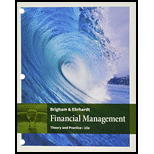
Bundle: Financial Management: Theory and Practice, Loose-leaf Version, 15th + Aplia, 1 term Printed Access Card
15th Edition
ISBN: 9781337130295
Author: Eugene F. Brigham, Michael C. Ehrhardt
Publisher: Cengage Learning
expand_more
expand_more
format_list_bulleted
Concept explainers
Question
Chapter 11, Problem 6P
a)
Summary Introduction
To determine: The cash flow of year 0.
b)
Summary Introduction
To determine: The net operating cash flows in year1, 2, and 3.
c)
Summary Introduction
To determine: The additional year 3 cash flow.
d)
Summary Introduction
To determine: whether the machine is to be purchased if cost of capital is 12%.
Expert Solution & Answer
Want to see the full answer?
Check out a sample textbook solution
Students have asked these similar questions
if $500 is placed in an account that earns a normal 6 % compounded quarterly, what will be worith in 10 years.
a. $907
b. $1,045
c. $980
d. $ 1,020
e. $117.48
what is the approximate yield to maturity (YTM) of a bond that is currently selling for $1,150 in the market place ? the annual bond has 20 years remaining until maturity and pays a 14% coupon. (assume annual interest payments and discounting)
a. 14%
b. 7%
c. 6%
d. 12%
If blurr image please comment i will write values.
please dont Solve with incorrect values otherwise unhelpful.
Chapter 11 Solutions
Bundle: Financial Management: Theory and Practice, Loose-leaf Version, 15th + Aplia, 1 term Printed Access Card
Ch. 11 - Why is it true, in general, that a failure to...Ch. 11 - Prob. 4QCh. 11 - Explain how net operating working capital is...Ch. 11 - How do simulation analysis and scenario analysis...Ch. 11 - Why are interest charges not deducted when a...Ch. 11 - Most firms generate cash inflows every day, not...Ch. 11 - What are some differences in the analysis for a...Ch. 11 - Distinguish among beta (or market) risk,...Ch. 11 - Prob. 11QCh. 11 - Prob. 1P
Ch. 11 - Prob. 2PCh. 11 - Prob. 3PCh. 11 - Prob. 4PCh. 11 - Prob. 5PCh. 11 - Prob. 6PCh. 11 - Prob. 7PCh. 11 - Prob. 10PCh. 11 - Shao Industries is considering a proposed project...Ch. 11 - The Everly Equipment Company’s flange-lipping...Ch. 11 - The Bartram-Pulley Company (BPC) must decide...Ch. 11 - The Yoran Yacht Company (YYC), a prominent...Ch. 11 - Prob. 1MCCh. 11 - Prob. 2MCCh. 11 - Prob. 3MCCh. 11 - Prob. 4MCCh. 11 - Prob. 5MCCh. 11 - Prob. 6MCCh. 11 - Prob. 7MCCh. 11 - Prob. 8MCCh. 11 - Prob. 14MC
Knowledge Booster
Learn more about
Need a deep-dive on the concept behind this application? Look no further. Learn more about this topic, finance and related others by exploring similar questions and additional content below.Similar questions
- Inferior Investment Alternatives Although investing requires the individual to bear risk, the risk can be controlled through the construction of diversified portfolios and by excluding any portfolio that offers an inferior return for a given amount of risk. While this concept seems obvious, one of your clients, Laura Spegele, is considering purchasing a stock that you believe will offer an inferior return for the risk she will bear. To convince her that the acquisition is not desirable, you want to demonstrate the trade-off between risk and return. While it is impractical to show the trade-off for all possible combinations, you believe that illustrating several combinations of risk and return and applying the same analysis to the specific investment should be persuasive in discouraging the purchase. Currently, U.S. Treasury bills offer 2.5 percent. Three possible stocks and their betas are as follows: 1. What will be the expected return and beta for each of the following portfolios? a.…arrow_forwardSolve this fin. Qn no aiarrow_forwardYou gave me unhelpful so i also gave you unhelpful.arrow_forward
- What is corporate finance? how many types of corporate finance??arrow_forwardEsfandairi Enterprises is considering a new three-year expansion project that requires an initial fixed asset investment of $2,350,000. The fixed asset will be depreciated straight-line to zero over its three-year tax life, after which time it will be worthless. The project is estimated to generate $3,310,000 in annual sales, with costs of $2,330,000. Assume the tax rate is 23 percent and the required return on the project is 11 percent. What is the project's NPV? Note: A negative answer should be indicated by a minus sign. Do not round intermediate calculations and round your answer to 2 decimal places, e.g., 32.16.arrow_forwardGyygvvv iiiedfarrow_forward
arrow_back_ios
SEE MORE QUESTIONS
arrow_forward_ios
Recommended textbooks for you
 EBK CONTEMPORARY FINANCIAL MANAGEMENTFinanceISBN:9781337514835Author:MOYERPublisher:CENGAGE LEARNING - CONSIGNMENT
EBK CONTEMPORARY FINANCIAL MANAGEMENTFinanceISBN:9781337514835Author:MOYERPublisher:CENGAGE LEARNING - CONSIGNMENT Fundamentals Of Financial Management, Concise Edi...FinanceISBN:9781337902571Author:Eugene F. Brigham, Joel F. HoustonPublisher:Cengage Learning
Fundamentals Of Financial Management, Concise Edi...FinanceISBN:9781337902571Author:Eugene F. Brigham, Joel F. HoustonPublisher:Cengage Learning

EBK CONTEMPORARY FINANCIAL MANAGEMENT
Finance
ISBN:9781337514835
Author:MOYER
Publisher:CENGAGE LEARNING - CONSIGNMENT

Fundamentals Of Financial Management, Concise Edi...
Finance
ISBN:9781337902571
Author:Eugene F. Brigham, Joel F. Houston
Publisher:Cengage Learning
Capital Budgeting Introduction & Calculations Step-by-Step -PV, FV, NPV, IRR, Payback, Simple R of R; Author: Accounting Step by Step;https://www.youtube.com/watch?v=hyBw-NnAkHY;License: Standard Youtube License